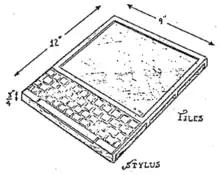 The Dynabook's original illustration in Alan C. Kay's 1972 paper | |
| Developer | Alan Kay |
|---|---|
| Release date | Concept 1972[1] |
The KiddiComp concept, envisioned by Alan Kay in 1968 while a PhD candidate,[2][3] and later developed and described as the Dynabook in his 1972 proposal "A personal computer for children of all ages",[1] outlines the requirements for a conceptual portable educational device that would offer similar functionality to that now supplied via a laptop computer or (in some of its other incarnations) a tablet or slate computer with the exception of the requirement for any Dynabook device offering near eternal battery life. Adults could also use a Dynabook, but the target audience was children.
Part of the motivation and funding for the Dynabook project came from the need for portable military maintenance, repair, and operations documentation. Eliminating the need to move large amounts of difficult-to-access paper in a dynamic military theatre provided significant US Department of Defense funding.
Though the hardware required to create a Dynabook is here today, Alan Kay still thinks the Dynabook hasn't been invented yet, because key software and educational curricula are missing. When Microsoft came up with its tablet PC, Kay was quoted as saying "Microsoft's Tablet PC, the first Dynabook-like computer good enough to criticize".[4]
Toshiba also has a line of sub-notebook computers called DynaBooks. In June 2018, Sharp acquired a majority stake in Toshiba's PC business including laptops and tablets sold under the Dynabook brand.[5][6]
Original concept
.jpg.webp)
Describing the idea as "A Personal Computer For Children of All Ages", Kay wanted the Dynabook concept to embody the learning theories of Jerome Bruner and some of what Seymour Papert— who had studied with developmental psychologist Jean Piaget and who was one of the inventors of the Logo programming language — was proposing. This concept was created two years before the founding of Xerox PARC. The ideas led to the development of the Xerox Alto prototype, which was originally called "the interim Dynabook".[7][8][9] It embodied all the elements of a graphical user interface, or GUI, as early as 1972. The software component of this research was Smalltalk, which went on to have a life of its own independent of the Dynabook concept.
The hardware on which the programming environment ran was relatively irrelevant.
At the same time, Kay tried in his 1972 article to identify existing hardware components that could be used in a Dynabook, including screens, processors and storage memory. For example:
A standalone 'smart terminal' that uses one of these chips for a processor (and includes memory, a keyboard, a display and two cassettes) is now on the market for about $6000.[1]
The Dynabook vision was most fully laid out in Kay’s 1977 article "Personal Dynamic Media", co-authored with collaborator (and Smalltalk co-inventor) Adele Goldberg.[9]
In 2019, Kay gave a detailed answer to a question on Quora, about the origins of the Dynabook concept.[10]
Later works
Since the late 1990s, Kay has been working on the Squeak programming system, an open source Smalltalk-based environment which could be seen as a logical continuation of the Dynabook concept.
He was actively involved in the One Laptop Per Child project, which uses Smalltalk, Squeak, and the concepts of a computer for learning.
References
- 1 2 3 Kay, Alan (1972). "A Personal Computer for Children of All Ages".
A standalone 'smart terminal' that uses one of these chips for a processor (and includes memory, a keyboard, a display and two cassettes) is now on the market for about $6 000
- ↑ Richards, Mike (January 23, 2008). "Why the iPhone makes 2008 seem like 1968 all over again". Open2. Archived from the original on November 12, 2011. Retrieved September 2, 2011.
- ↑ Steinberg, Daniel H. (April 3, 2003). "Daddy, Are We There Yet? A Discussion with Alan Kay". OpenP2P.com. O'Reilly. Archived from the original on November 15, 2017.
- ↑ Levy, Steven (April 30, 2001). "Bill Gates Says, Take This Tablet". Newsweek.
- ↑ 東芝のPC、シャープ売却後も名前は「TOSHIBA」, 朝日新聞 (Asahi Shimbun).
- ↑ "Sharp to Buy Toshiba's Personal Computer Business, License Brand", Bloomberg, June 5, 2018
- ↑ "40th Anniversary of the Dynabook", Computer History Museum, archived from the original on November 8, 2008, retrieved November 4, 2008.
- ↑ "The Laptop Celebrates 40 Years", Wired, November 2008.
- 1 2 Kay, Alan C.; Goldberg, Adele (March 1977). "Personal Dynamic Media". Computer. 10 (3): 31–41. doi:10.1109/c-m.1977.217672. S2CID 15070347.
- ↑ Kay, Alan. "Alan Kay's answer to American computer pioneer Alan Kay's concept, the Dynabook, was published in 1972. How come Steve Jobs and Apple iPad get the credit for tablet invention?". Quora. Retrieved April 21, 2019.
External links
- Gruener, Wolfgang (April 17, 2010), "Did Steve Jobs Steal The iPad? Genius Inventor Alan Kay Reveals All", Tom's Hardware.
- Kay, Alan C (August 1972), A Personal Computer for Children of All Ages (PDF), DE: M Prove.
- Kay, Alan C (January 10, 1986). The Dynabook—Past Present and Future, Excerpts from The ACM Conference on the History of the Personal Workstations (video). youtube.com. Computer History Museum.
- "The World in your Own Notebook", The Best of Creative Computing, Atari archives, vol. 3, p. 5.
- "From the Dynabook to Squeak – A Study in Survivals", Thinkubator, CA: SFU, archived from the original on December 4, 2012.
- "Tracing the Dynabook: A Study of Technocultural Transformations", Thinkubator (PhD dissertation), CA: SFU, archived from the original on December 4, 2012 about the Dynabook project and vision
- "Toshiba's dynabook R – a lowcost (185$) tablet PC", Uber gizmo, February 2005.
- "An Interview with Computing Pioneer Alan Kay", Time, April 2, 2013.